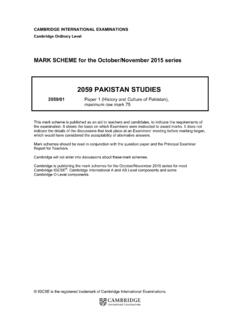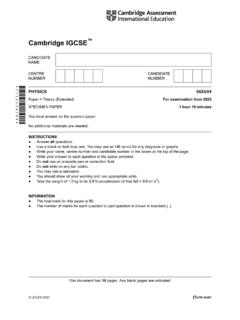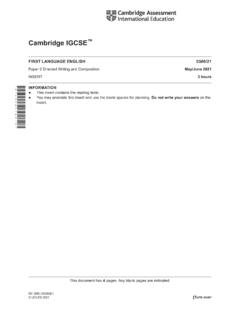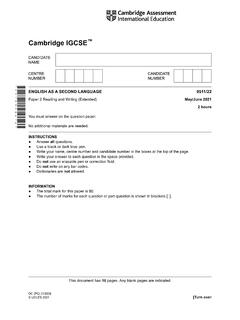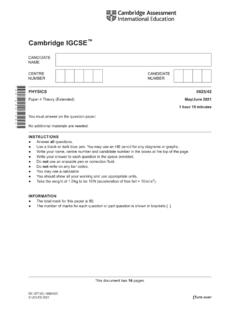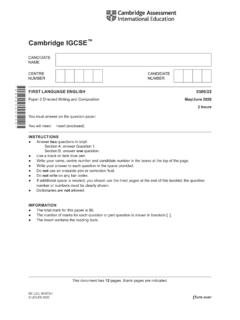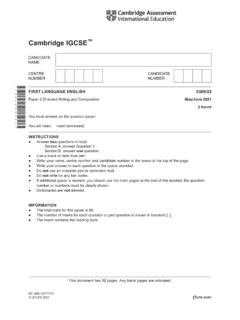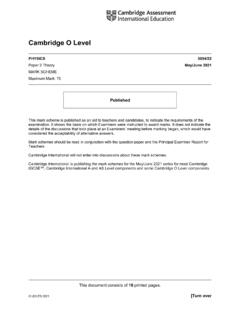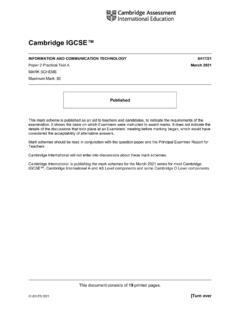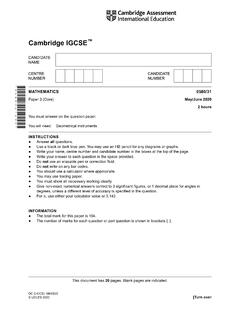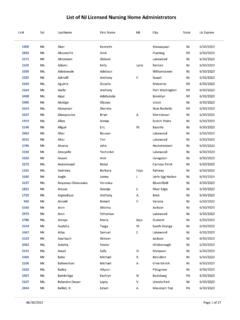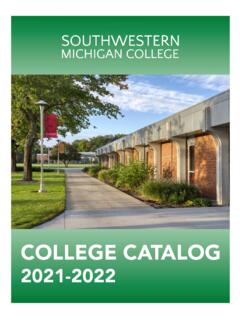Transcription of 0500 w20 ms 12 - GCE Guide
1 This document consists of 20 printed pages. UCLES 2020 [Turn over Cambridge IGCSE FIRST LANGUAGE ENGLISH 0500/12 Paper 1 Reading October/November 2020 MARK SCHEME Maximum Mark: 80 Published This mark scheme is published as an aid to teachers and candidates, to indicate the requirements of the examination. It shows the basis on which Examiners were instructed to award marks. It does not indicate the details of the discussions that took place at an Examiners meeting before marking began, which would have considered the acceptability of alternative answers. Mark schemes should be read in conjunction with the question paper and the Principal Examiner Report for Teachers.]
2 Cambridge International will not enter into discussions about these mark schemes. Cambridge International is publishing the mark schemes for the October/November 2020 series for most Cambridge IGCSE , Cambridge International A and AS Level and Cambridge Pre-U components, and some Cambridge O Level components. 0500/12 Cambridge IGCSE Mark Scheme PUBLISHED October/November2020 UCLES 2020 Page 2 of 20 Generic Marking Principles These general marking principles must be applied by all examiners when marking candidate answers. They should be applied alongside the specific content of the mark scheme or generic level descriptors for a question. Each question paper and mark scheme will also comply with these marking principles.
3 GENERIC MARKING PRINCIPLE 1: Marks must be awarded in line with: the specific content of the mark scheme or the generic level descriptors for the question the specific skills defined in the mark scheme or in the generic level descriptors for the question the standard of response required by a candidate as exemplified by the standardisation scripts. GENERIC MARKING PRINCIPLE 2: Marks awarded are always whole marks (not half marks, or other fractions). GENERIC MARKING PRINCIPLE 3: Marks must be awarded positively: marks are awarded for correct/valid answers, as defined in the mark scheme. However, credit is given for valid answers which go beyond the scope of the syllabus and mark scheme, referring to your Team Leader as appropriate marks are awarded when candidates clearly demonstrate what they know and can do marks are not deducted for errors marks are not deducted for omissions answers should only be judged on the quality of spelling, punctuation and grammar when these features are specifically assessed by the question as indicated by the mark scheme.
4 The meaning, however, should be unambiguous. GENERIC MARKING PRINCIPLE 4: Rules must be applied consistently, in situations where candidates have not followed instructions or in the application of generic level descriptors. GENERIC MARKING PRINCIPLE 5: Marks should be awarded using the full range of marks defined in the mark scheme for the question (however, the use of the full mark range may be limited according to the quality of the candidate responses seen). GENERIC MARKING PRINCIPLE 6: Marks awarded are based solely on the requirements as defined in the mark scheme. Marks should not be awarded with grade thresholds or grade descriptors in mind.
5 0500/12 Cambridge IGCSE Mark Scheme PUBLISHED October/November2020 UCLES 2020 Page 3 of 20 Note: All examiners are instructed that alternative correct answers and unexpected approaches in candidates scripts must be given marks that fairly reflect the relevant knowledge and skills demonstrated. Nonetheless, the content must be clearly related to and derived from the texts. Question 1 This question tests reading assessment objectives R1, R2 and R5 (25 marks): R1 demonstrate understanding of explicit meanings R2 demonstrate understanding of implicit meanings and attitudes R5 select and use information for specific purposes and Question 1(f) only tests writing assessment objectives W2, W3 and W5 (5 marks): W2 organise and structure ideas and opinions for deliberate effect W3 use a range of vocabulary and sentence structures appropriate to context W5 make accurate use of spelling, punctuation and grammar.
6 Overview of items for Question 1 Item Assessment objectives tested Marks for assessment objectives 1(a) R5 1 1(b)(i) R1 2 1(b)(ii) R1 2 1(c) R1 and R2 2 1(d)(i) R1, R2 and R5 2 1(d)(ii) R1 and R5 3 1(e) R1 and R2 3 1(f) R1,R2 and R5 W2, W3 and W5 10 5 Total 30 0500/12 Cambridge IGCSE Mark Scheme PUBLISHED October/November2020 UCLES 2020 Page 4 of 20 Question Answer Marks 1(a) Give two examples of animals that have been culled, according to the text.
7 Award 1 mark for both responses. deer grey squirrel 1 1(b)(i) Using your own words, explain what the text means by: appropriate method (line 1): Award 2 marks for full explanation (both strands). Award 1 mark for partial explanation. suitable / fitting / sensible / right / correct / efficient / effective / can be argued as reasonable procedure / process / way (of doing) / approach / solution Credit alternatives explaining the whole phrase, what they need to do in the circumstances. 2 1(b)(ii) Using your own words, explain what the text means by: Large numbers (line 4): Award 2 marks for full explanation (both strands).
8 Award 1 mark for partial explanation. vast / enormous / big / huge amount / population / group(s) Credit alternatives explaining the whole phrase, lots of deer / lots of them / (too) many / numerous / multitude(s) / quantities. 2 1(c) Re-read paragraph 3, ( This type of conservation .. and the environment. ). Give two reasons why people might be against cutting down trees. misguided judgement / misguided attempt to save what is seen as the most important, pretty or useful of the species / only saving the trees that are judged important, pretty or useful / subjective decision (little regard for) natural progression (of wildlife and the environment) / interfering with natural progression 2 0500/12 Cambridge IGCSE Mark Scheme PUBLISHED October/November2020 UCLES 2020 Page 5 of 20 Question Answer Marks 1(d)(i) Re-read paragraphs 4 and 5, ( However, we must.)
9 In their movements. ). Identify two reasons why cutting down trees is important. restores balance within the environment / keeps a well-rounded spread of species / allows more than just the fittest and fastest-to-adapt species to survive we rely on other species for survival allows free movement of mammals / free roaming mammals not there to do it (for us) / replaces the effect of free roaming mammals 2 1(d)(ii) Re-read paragraphs 4 and 5, ( However, we must .. in their movements. ). Explain how mammals once helped to maintain the natural balance in the woodlands. Award 1 mark for each idea, up to a maximum of 3. brought down trees eat different trees and vegetation / eat (specific) varieties of trees and vegetation animals roamed around / (keeping/kept) the area varied and dynamic / ensured diversity in forest / moving around freely 3 1(e) Re-read paragraph 7, ( It can seem.
10 Insects and berries. ). Using your own words, explain why birds like blue tits and nightingales are not usually found in dense woodland areas. Award 1 mark for each idea, predominantly in own words, up to a maximum of 3. Answers which are entirely in the words of the text should not be credited. These birds are not usually found in dense woodland areas because: very little light / dark(er) less vegetation / less varied vegetation less food for the birds to eat / fewer insects / fewer berries / they choose to occupy thickets with easier access to their food source 3 0500/12 Cambridge IGCSE Mark Scheme PUBLISHED October/November2020 UCLES 2020 Page 6 of 20 Question Answer Marks 1(f) According to Text B, what makes the cherry blossom season in Japan so popular?
